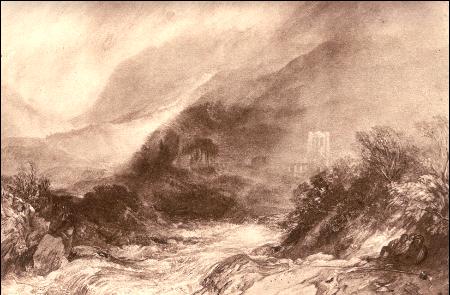
By Kind Permission of Lancaster University Library

By Kind Permission of Lancaster University Library
Engraved by Willmore after Turner. ( England and Wales. Rawlinson 287. Wilton 863.)
Llanthony, Monmouthshire. Ruskin considered that 'No conception can be formed of this picture from the engraving' ( MP I:247). The original watercolour was at some time in Ruskin's collection ( Works, 13.601), but although he praised it highly he eventually sold it because, as he explained in a letter to the Times of 14 April 1886, 'it possessed none of Turner's distinctive qualities, but was merely an effect of Copley Fielding's better executed' ( Works, 13.590). Nevertheless in Praeterita he still referred to it as one of the 'matchless' Turner s hanging in the Denmark Hill breakfast room ( Works, 35.380). In his pamphlet PreRaphaelitism (1851), Ruskin describes the watercolour as one of the 'grandest drawings' in which 'either sky, water, or figures are in rapid motion' ( Works, 12.376) and explains that the composition is developed from a much earlier sketch, producing 'one of the very noblest of his second period' ( Works, 12.382-3).
J.M.W. Turner 1775-1851
Llanthony Abbey, Monmouthshire c.1835
Watercolour and some body colour, 29.8x42.6cm
Exhibitions: RA 1974 (430)
Engraving:
Engraved by J.T. Willmore, 1836
Copper engraving, 16.8x23.8cm
Engraved for the England and Wales series
Provenance: John Ruskin; J.E. Taylor, sale Christie's 5/7/1912 (48), bt. Agnew; Kurt Pantzer; given to the museum in memory of Dr and Mrs Hugo O. Pantzer by their children
Collection: Indianapolis Museum of Art